

Soda Drinking Linked to Six Major Diseases. The only safe soda is the one not consumed - that goes for fruit juice drinks as well.
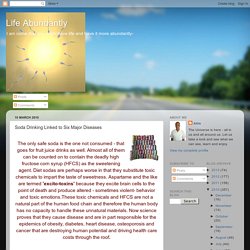
Almost all of them can be counted on to contain the deadly high fructose corn syrup (HFCS) as the sweetening agent. Diet sodas are perhaps worse in that they substitute toxic chemicals to impart the taste of sweetness. Aspartame and the like are termed 'excito-toxins' because they excite brain cells to the point of death and produce altered - sometimes violent- behavior and toxic emotions.These toxic chemicals and HFCS are not a natural part of the human food chain and therefore the human body has no capacity to handle these unnatural materials. Synthetic food coloring and behavior: a dose response effect in a double-blind, placebo-controlled, repeated-measures study - PubMed. Objective: To establish whether there is an association between the ingestion of synthetic food colorings and behavioral change in children referred for assessment of "hyperactivity.

" Participants: From approximately 800 children referred to the Royal Children's Hospital (Melbourne) for assessment of suspected hyperactivity, 200 were included in a 6-week open trial of a diet free of synthetic food coloring. The parents of 150 children reported behavioral improvement with the diet, and deterioration on the introduction of foods noted to contain synthetic coloring. A 30-item behavioral rating inventory was devised from an examination of the clinical histories of 50 suspected reactors. Thirty-four other children (23 suspected reactors, 11 uncertain reactors) and 20 control subjects, aged 2 to 14 years, were studied. The Top foods with MSG (monosodium glutamate) to Avoid. TOXIC SHOCK. Is Carrageenan A Safe Food Additive for Gluten Free Foods? Study reveals microplastics can even be found in beer. It appears nothing is safe from plastic pollution anymore - not even the beer we drink.
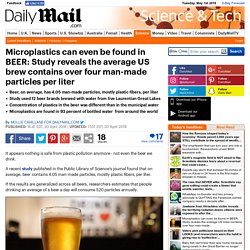
A recent study published in the Public Library of Science's journal found that on average, beer contains 4.05 man-made particles, mostly plastic fibers, per liter. If the results are generalized across all beers, researchers estimates that people drinking an average of a beer a day will consume 520 particles annually. A recent study analyzing 12 different kinds of beers containing water from five Great Lakes found that the beverages contain an average of 4.05 man-made particles, mostly plastic fibers, per liter The team of three researchers analyzed 12 different beers between January and April of last year. All of the beverages contained water from one of the five Laurentian Great Lakes: Lake Superior, Lake Michigan, Lake Huron, Lake Erie, and Lake Ontario.
Microplastics are classified as plastic debris that is than five millimeters in length, according to the National Ocean and Atmosphere Administration. WATCH TO BELIEVE YOUR EYES. List Of Foods Containing Nanoparticles, & Organic ... Not So Organic. Mayo's Mind: 16 Food Additives You Shouldn't Eat. UPDATE: Because of a convincing argument made by Chris Kresser, I've removed nitrates/nitrites from this list.

For thousands of years, humans have used spices to preserve and taste-enhance food. These spices were so important that wars were fought over them. Then, a couple hundred years ago, the newly created chemical industry started developing natural and synthetic preservatives, nutrients, and taste enhancers for the processed food industry. EXCLUSIVE: Quaker instant oatmeal and Silk non-GMO soy creamer found contaminated with alarming levels of glyphosate weed killer... and they're not even GMO!
"Our Daily Poison:" A Stark Look at Our Toxic Food Supply. By Dr.

Mercola How many chemicals are you exposed to on a daily basis? There's no way to know for sure, but chances are toxic chemicals are in your food and many items you touch hundreds, if not thousands, of times a day.What is known that your toxic burden is largely related to your purchasing decisions and lifestyle. While environmental pollution is certainly a factor, primary routes of chronic exposure include your diet, and personal care and household products.Tests have confirmed that those who eat non-organic foods and use chemical-based products tend to have far higher levels of toxins in their system. Your choice of building materials and furniture can also play a role, as many contain toxic chemicals like flame retardants. Toxins in Food and Plastics Are Fueling Chronic Disease Health statistics suggest the toxic burden is becoming too great for children and adults alike, and toxins in our food appear to play a primary role.According to Joseph E.
Our Daily Poison. Energy Drinks: Beyond Dangerous, They Can Be Deadly! Photo credit: bigstock.com Energy drinks: they are all around us.
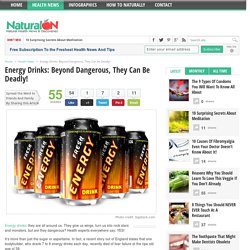
They give us wings, turn us into rock stars and monsters, but are they dangerous? Health experts everywhere say: YES! It’s more than just the sugar or aspartame. More Bad News For Diet Soda Lovers. Photo credit: bigstock.com Unfortunately, one trip to any restaurant or supermarket will reveal that far too many people still believe that they go for a ‘healthier’ option by choosing a diet soda rather than the regular sugar filled kind.
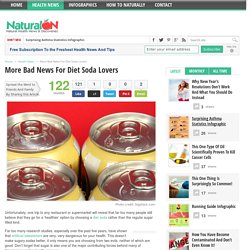
Far too many research studies, especially over the past five years, have shown that artificial sweeteners are very, very dangerous for your health. Top 20 Dangerous Foods You Absolutely Must Avoid - NaturalON. Photo credit: bigstock Everyone knows the foods that are healthy and those that are not, right?
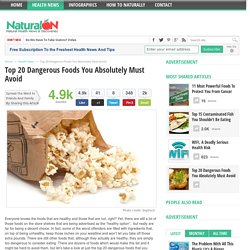
Yet, there are still a lot of those foods on the store shelves that are being advertised as the “healthy option”, but really are far for being a decent choice. A complete list of artificial ingredients. FDA admits not knowing about existence of many food chemicals, let alone their safety. (NaturalNews) The explosive introduction of new food additives, in addition to an easing of some federal oversight requirements, has allowed manufacturers to dodge scrutiny from the Food and Drug Administration, the agency responsible for ensuring the safety of chemicals that are flowing into the food supply.
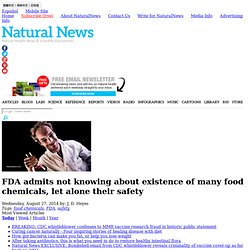
And, as reported by The Washington Post, in hundreds of cases the FDA is not even aware of the existence of new additives, which can include chemical preservatives, thickening agents and flavorings, interviews and records have shown. "We simply do not have the information to vouch for the safety of many of these chemicals," said Michael Taylor, the FDA's deputy commissioner for food, in an interview with the Post. The paper further reported: The FDA has received thousands of consumer complaints about additives in recent years, saying certain substances seem to trigger asthmatic attacks, serious bouts of vomiting, intestinal-tract disorders and other health problems.
Sources: Battle for humanity nearly lost: global food supply deliberately engineered to end life, not nourish it - NaturalNews.com. Do you have poison on your plate? - NaturalNews.com. 'Safety assessments' on nearly all common food additives found to be manipulated by processed food industry: Study. (NaturalNews) New research published in the journal, JAMA Internal Medicine, has verified that the vast majority of the 10,000-or-so chemical additives currently allowed in food are backed only by industry-funded and supported safety assessments.

And a large percentage of these have never even been submitted to the U.S. Food and Drug Administration (FDA) for review, which means the general population is essentially being used as a collective guinea pig in a giant food additive safety experiment. Between 1997 and 2012, the FDA reportedly received 451 voluntary notifications about new food additives, 100 percent of which came from individuals and groups connected in one way or another to the food industry.
Rather than be accompanied by independent safety research, every single one of these new additives came with "safety data" conjured by the companies that produce them, a serious conflict of interest that apparently has become the standard rather than the exception. Food - The Ultimate Secret Exposed. Study: Monsanto’s Roundup causes “gluten intolerance” Jon RappoportActivist Post A recent study proposes that gluten intolerance and celiac disease are on the rise as a result of glyphosate, the main ingredient in Monsanto’s Roundup herbicide. The National Library of Medicine states that celiac disease “damages the lining of the small intestine and prevents it from absorbing parts of food that are important for staying healthy. The damage is due to a reaction to eating gluten, which is found in wheat, barley, rye, and possibly oats.” Harmful if swallowed - The dangers of food irradiation. (NaturalNews) Food irradiation was implemented to eradicate potentially harmful substances that pose health risks to consumers.
The Food and Drug Administration (FDA) has long ago approved irradiation for products including meats, fruits and vegetables. While eliminating dangerous bacteria sounds like a step in the right direction, the research behind food irradiation is highly flawed. Irradiation wipes out good bacteria as well as the harmful kinds. Good bacteria found in foods curb the growth of dangerous bacteria and produce an odor that indicates spoilage. 10 Worst Food Ingredient List. 1. Monosodium Glutamate (MSG) WHAT IT IS: MSG is an amino acid used as a flavor-enhancer in processed foods (one of the most common food additives).
WHY IT’S BAD: It’s an known excitotoxin, which is a neurotoxic chemical additive shown to harm nerve cells— overexciting them, sometimes to the point of cell death. Regularly consuming excitotoxins like MSG destroys significant numbers of brain cells and can lead to serious health problems, including neurological disorders. How Government Allows Dangerous Food Additives Like MSG To Stay in Our Food. Melissa MeltonActivist Post “The thing that bugs me is that the people think the FDA is protecting them. It isn’t. How Many Steps Does It Take to Make MSG? MSG is so natural that it only takes GMO bacteria, 17+ steps and a lab to make it. Aaron Dykes and Melissa MeltonActivist Post …because a natural food cooking process always involves treating genetically modified bacteria with penicillin, lye, a vat of acid, cryogenic freezing, silicon oil, and more lye… Monosodium Glutamate (MSG) has become a very popular food additive over the past century, with Japanese scientists first isolating from seaweed for industrial purposes.
The appeal, and danger, of MSG comes from the intense flavors of the free glutamate form of the non-essential amino acid, glutamic acid, which also delivers rapid stimulation to the brain and central nervous system when not in the bound form. Sewage Sludge: Whole Foods Quietly Agrees To Drop Waste Grown Produce. Human waste found in Chinese soy sauce. Study: Exposure to BPA Leads to Diseases Including Cancer.
"We believe that BPA actually reprograms the stem cells to be more sensitive to estrogen throughout life, leading to a life-long increased susceptibility to diseases including cancer. " - Professor Gail Prins University of Chicago. Cheap tea bags contain frighteningly high fluoride levels: Study. (NaturalNews) A new study published in the journal, Food Research International, has revealed that millions of people across the globe are at serious risk of developing tooth decay, bone loss, and other serious health conditions as a result of over-exposure to fluoride.
Many inexpensive, store brand black and green teas, it turns out, contain dangerously high levels of fluoride that far exceed even the government's over-inflated maximums for fluoride exposure. Though it focused mainly on private label tea brands sold in the U.K., the study identified what is presumably a reality in many developed nations -- cheap teas generally contain levels of fluoride so high that drinking them may be considered unsafe.
Based on an analysis of 38 different tea brands, Ph.D. student Laura Chan and her colleagues from the University of Derby found that fluoride levels averaged around six milligrams per liter (mg/l) in store brand tea. The Forensic Food Lab. Which parts of America are the most contaminated with arsenic? The Eyes Have It: Pesticides Stop Sweet Potatoes from Growing Shoots.